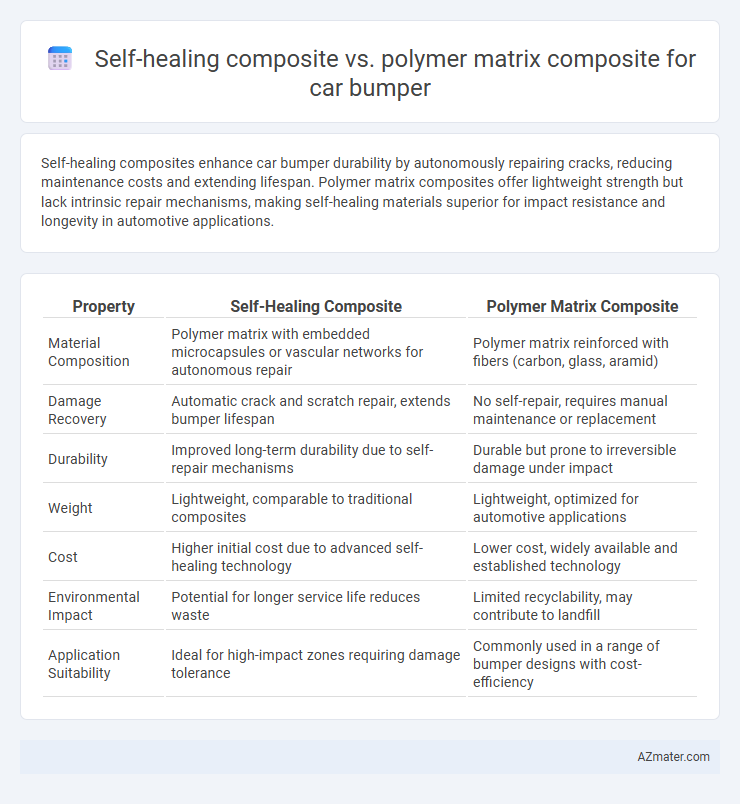Self-healing composites enhance car bumper durability by autonomously repairing cracks, reducing maintenance costs and extending lifespan. Polymer matrix composites offer lightweight strength but lack intrinsic repair mechanisms, making self-healing materials superior for impact resistance and longevity in automotive applications.
Table of Comparison
| Property | Self-Healing Composite | Polymer Matrix Composite |
|---|---|---|
| Material Composition | Polymer matrix with embedded microcapsules or vascular networks for autonomous repair | Polymer matrix reinforced with fibers (carbon, glass, aramid) |
| Damage Recovery | Automatic crack and scratch repair, extends bumper lifespan | No self-repair, requires manual maintenance or replacement |
| Durability | Improved long-term durability due to self-repair mechanisms | Durable but prone to irreversible damage under impact |
| Weight | Lightweight, comparable to traditional composites | Lightweight, optimized for automotive applications |
| Cost | Higher initial cost due to advanced self-healing technology | Lower cost, widely available and established technology |
| Environmental Impact | Potential for longer service life reduces waste | Limited recyclability, may contribute to landfill |
| Application Suitability | Ideal for high-impact zones requiring damage tolerance | Commonly used in a range of bumper designs with cost-efficiency |
Introduction to Composite Materials in Car Bumpers
Self-healing composites in car bumpers incorporate advanced materials capable of autonomously repairing micro-cracks, enhancing durability and extending service life compared to conventional polymer matrix composites (PMCs). PMCs, commonly composed of polymers reinforced with fibers such as glass or carbon, offer lightweight and corrosion-resistant properties critical for impact absorption and energy dissipation in automotive safety. The integration of self-healing mechanisms in composite structures represents a significant innovation, improving maintenance efficiency and reducing long-term repair costs in automotive applications.
Overview of Polymer Matrix Composites (PMC)
Polymer Matrix Composites (PMCs) consist of a polymer resin matrix reinforced with fibers such as glass, carbon, or aramid, offering high strength-to-weight ratios ideal for automotive applications like car bumpers. These composites provide excellent impact resistance, corrosion resistance, and design flexibility, enhancing vehicle safety and weight reduction. Advances in self-healing composites introduce microcapsules or vascular networks within the PMC structure, enabling autonomous repair of damage, which improves durability and lowers maintenance costs over traditional PMCs.
What Are Self-Healing Composites?
Self-healing composites are advanced materials designed to automatically repair damage such as cracks or scratches, enhancing the durability and lifespan of car bumpers. Unlike traditional polymer matrix composites, which require manual repair when damaged, self-healing composites integrate microcapsules or vascular networks containing healing agents that activate upon impact. These innovative composites improve safety and reduce maintenance costs by restoring structural integrity without external intervention.
Material Composition: PMC vs Self-Healing Composites
Polymer Matrix Composites (PMCs) for car bumpers typically consist of a polymer resin such as epoxy or polyester reinforced with fibers like glass or carbon, providing strength and lightweight properties. Self-healing composites incorporate microcapsules or vascular networks filled with healing agents within the polymer matrix, enabling automatic repair of cracks or damage to maintain structural integrity. This advanced material composition enhances durability and reduces maintenance by restoring mechanical properties without external intervention, unlike conventional PMCs.
Mechanical Properties Comparison
Self-healing composites for car bumpers exhibit improved impact resistance and damage recovery compared to traditional polymer matrix composites, enhancing durability and safety. The polymer matrix composites, typically made from epoxy or polyester resins, offer high tensile strength and stiffness but lack autonomous repair capabilities, leading to potential failure after repeated impacts. Self-healing composites integrate microcapsules or vascular networks that repair micro-cracks, maintaining mechanical integrity and extending the bumper's lifespan under dynamic loading conditions.
Impact Resistance and Durability
Self-healing composites enhance car bumper impact resistance by autonomously repairing microcracks, extending service life and reducing maintenance costs compared to traditional polymer matrix composites. Polymer matrix composites, while lightweight and corrosion-resistant, often suffer from irreversible damage under high impact, limiting long-term durability. Incorporating self-healing agents significantly improves resilience, making these advanced materials ideal for automotive safety applications.
Repair and Maintenance Considerations
Self-healing composites in car bumpers reduce repair and maintenance costs by autonomously addressing micro-cracks and minor damages, extending service life without manual intervention. Polymer matrix composites require traditional repair methods such as patching or replacement, which involve higher labor and material expenses. The intrinsic repair capability of self-healing composites enhances durability and minimizes downtime compared to conventional polymer matrix composites.
Cost-Effectiveness and Manufacturing Processes
Self-healing composites in car bumpers offer enhanced durability by autonomously repairing minor damages, potentially reducing long-term maintenance costs compared to traditional polymer matrix composites, which require more frequent repairs or replacements. However, the manufacturing processes for self-healing composites are currently more complex and expensive due to advanced material formulations and specialized curing techniques, resulting in higher initial production costs. Polymer matrix composites, widely used in automotive applications, benefit from established, cost-efficient manufacturing methods such as injection molding and compression molding, making them more economically viable for mass production despite less damage resilience.
Environmental Impact and Sustainability
Self-healing composites for car bumpers significantly reduce environmental impact by extending the lifespan of components, thereby decreasing waste and resource consumption compared to traditional polymer matrix composites. These advanced materials enable autonomous repair of micro-cracks, minimizing the need for replacements and lowering the carbon footprint associated with manufacturing and disposal. Sustainable production methods and the potential for recycling further enhance the ecological benefits of self-healing composites in automotive applications.
Future Trends in Car Bumper Composite Technology
Self-healing composites for car bumpers are emerging as a revolutionary advancement, offering enhanced durability by autonomously repairing micro-cracks and extending the bumper's lifespan, significantly reducing maintenance costs. Polymer matrix composites, traditionally used for their lightweight and high-strength properties, continue evolving with nanomaterial reinforcements to improve impact resistance and energy absorption. Future trends emphasize integrating self-healing capabilities with advanced polymer matrices, creating smart, sustainable bumpers that combine resilience, weight reduction, and environmental benefits.

Infographic: Self-healing composite vs Polymer matrix composite for Car bumper
 azmater.com
azmater.com